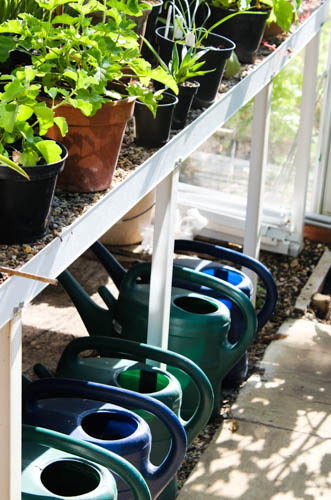
While temperatures remain high, watering and ventilation are top of the list. Open vents early in the morning, as temperatures in the greenhouse soon rise (shading should be in place by now), water preferably in the evening or early morning and check plants several times a day to ensure that they don’t dry out.
Consider using ‘grey’ water from the shower, bath, kitchen or from washing machine rinse cycles on ornamental plants in the greenhouse. Keep detergent levels like shower gel to a minimum and don’t store grey water for longer than 24 hours. Softened tap and dishwasher water are useful but only as a very temporary measure and water containing bleach and disinfectants are a ‘no no’, of course. It is at times like these when past efforts you put into collecting rainwater really pays off and don’t waste it. Water at the base of the plant around the roots, not over the leaves, learn to estimate how much each pot needs and store your watering cans under the bench to catch the drips of water draining from the bench. When you carry the can from tap to greenhouse you are more careful with the water you use. Keep your greenhouse pots and borders weed free, so the plants, not weeds use the water and when the rains arrive again, flush out the compost with fresh, unadulterated rain water.
Keep twining cucumber stems round their supports and cut back the side shoots two leaves beyond the flowers and fruits, to increase airflow and reduce chances of mildew – keeping foliage dry, the plants well-watered and mulching also reduces the risk of mildew and use resistant varieties like ‘Carmen’, ‘Passandra’ and ‘Bella’ are well worth growing. Harvest cucumbers when fruits are about 30cm long and water with high potash fertilizer to encourage further fruiting.
Check regularly for signs of pests, like whitefly and red spider (or ‘two spotted’) mite. Before introducing biological controls use environmentally friendly sprays containing fatty acids, plant invigorators, plant extracts or plant oils as others leaving chemical residues will kill them. A relatively new product, SB plant invigorator developed by a commercial Tomato grower and based on organic soap, controls a wide range of pest species including Whitefly, Spider Mite and Mealybug plus mildew and other fungal problems, it’s a useful foliar feed, too and is biodegradable, non-toxic and there is no interval between spraying and harvest. This amazingly versatile ‘super’ product is a real boost to gardeners. Whitefly can then be controlled using Encarsia formosa, Red spider mite (or two spotted mite) by increasing humidity around the plant or introducing predators like the mite Phytoseiulus persimilis, midge Feltiella acrarsuga or a rove beetle, Atheta coriaria.
Feed fruiting crops like sweet peppers and chilli’s according to the manufacturer’s instructions, continue removing side shoots from tomatoes, tap the open flowers to encourage pollination and tie the stems to canes or supporting string as they grow. Keep the compost moist as erratic watering causes splitting and ‘blossom end rot’.
Keep the greenhouse free of damaged or diseased material and sweep the paths as plant debris can harbor pests and diseases, it looks more professional, too and when you have finished all of this, sit out in the garden and enjoy the sunshine – summer’s like this are a rare treat.
Happy gardening. Matt


